
Focus: Subscription Economy - The Future of Business Models
Rensi Widjaja

Despite having been around since the 17th century, subscription-based businesses have garnered attention only recently with the success of companies like Salesforce, Netflix, Adobe, and Microsoft. In the past five years, subscription model businesses have grown by more than 100% annually with an increase from USD 57 million in 2011 to USD 2.6 billion in 2016 (Stanford GSB, McKinsey).
Due to the popularity of Software as a Service (SaaS), at first glance, the subscription-based model is often more closely associated with technology companies. However, this is not the case anymore. From meal boxes to shaving to heavy equipment to fitness classes, over the past decades, businesses across various industries have started to adopt a subscription model. This wave has set off what could be the next major shift since the industrial revolution: the subscription economy.
The subscription-based business model is a concept where customers pay a recurring price at regular intervals for access to a product or service. The model is designed to keep customers engaged for a long-term relationship with the business. According to Tien Tzuo, CEO of Zuora, the question subscription businesses face has changed from “How to get a product to the market?” to “How can I meet customers through the channels they use?”. Zuora is an enterprise software company that creates the technology infrastructure needed for subscription-based businesses. Through its platform, businesses can manage quotes, orders and billing. Zuora is founded by Tien Tzuo, who is one of the first few employees at Salesforce. His expertise in subscription models has made him a well-regarded thought leader on the subject. The growth of Zuora itself is a testament on how subscription businesses are growing rapidly. The company recorded a staggering revenue growth at approximately 25% CAGR for the last 5 years. Zuora client base spans globally across high profile companies in various sectors.
Tzuo’s philosophy is that at the very core, customers (not the product) are at the center of the subscription-based business model. This shift has evolved the traditional text book model from linear transactional channels to a circular, more dynamic lifecycle. (See Exhibit 1).

Instead of creating a hit product that will be sold once, the idea is to convert these one-off purchases to ongoing recurring sales by offering new content with more customization. The result? Successful companies often get high renewal rates. In turn, businesses get to enjoy a recurring cash inflow allowing more visibility to future revenue stream. This is of the upmost importance. As companies get better visibility, they will be able to better manage their resources towards important areas like research and development to spur growth and innovation.
In the words of Satya Nadella, CEO of Microsoft, for companies, the focus now has shifted to utilization rather than acquisition. How to deliver the ultimate experience for customers using your product or service so that they would be willing to spend more?
If you have been following closely, Apple is in the middle of a structural transformation of its business model. Since 2018, as iPhone revenue growth falters, Apple has been quite vocal in its change of focus. The company is trying to accelerate revenue growth using a different engine, its service business. In 2016, Goldman Sachs analyst, Simona Jankowski suggested an Apple subscription bundle for its hardware and services. Just last week, Apple announced Apple One where users can enjoy a subscription bundling including Apple music, Apple News, Apple TV+, Apple Arcade, iCloud and many more. By adopting this model, it became clear that Apple is essentially focusing on user monetization of Apple IDs. As suggested by Jankowski, it might not be long before Apple also comes up with a subscription service for its hardware.
According to Zuora’s Subscription Economy Index, subscription-based revenue grew at 18.1% CAGR over the last 7 years (2012-2019). To put it into perspective, this is five times faster than the S&P 500 (3.6%) and US retail sales (3.7%). The data is compiled quarterly based on billions of dollars of revenue and financial transactions from various industry benchmarks (See Exhibit 2).
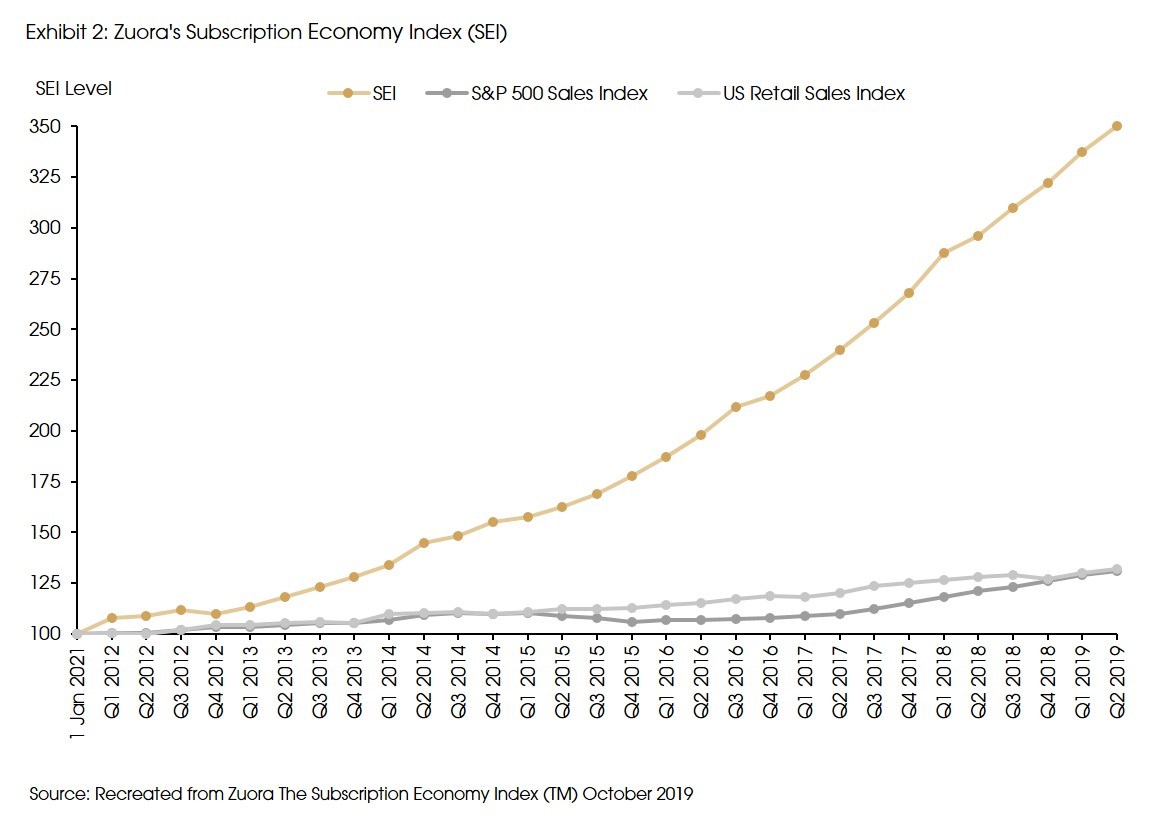
It is interesting to note that the subscription business is evolving to become industry agnostic. It has been used by various businesses in areas that we would have never imagined. For example, currently there’s a subscription service for guitars, pest exterminator, jet engines, tractors, and even elevators. Some of the fastest growing sectors include: Healthcare, Education, Insurance, Utilities, Real Estate, and Pet Care.
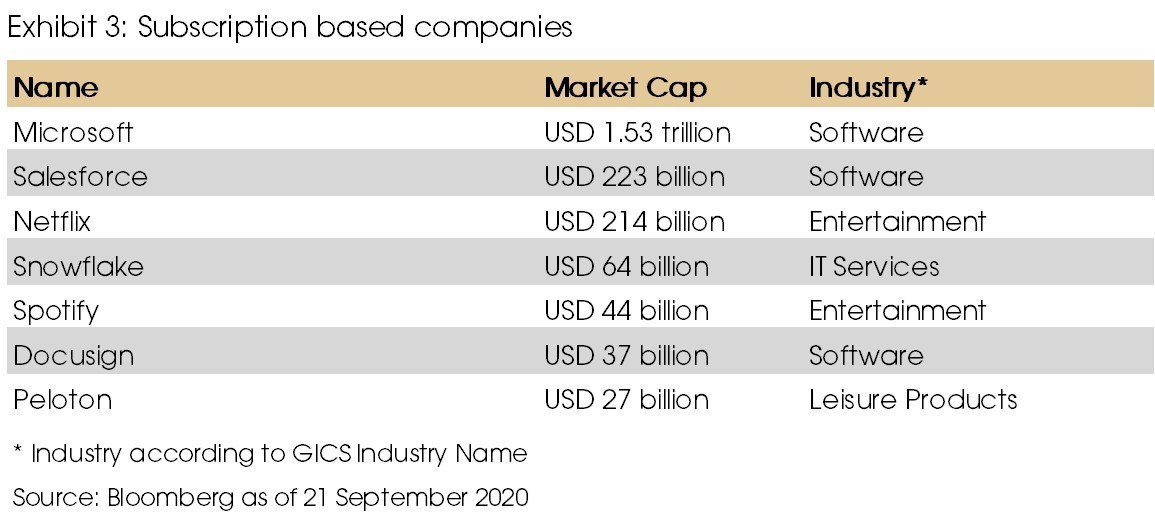
In the grand scheme of things, the adoption of the subscription-based model could also have a positive impact for a more sustainable world as it maximizes the use of materials and resources. It could very well eliminate the “buy and waste” mentality.
The New Customer Mindset
Consumer purchasing behavior is a gold mine that every business is trying to dig. Understanding your costumers is imperative to the success of every business but even more so for a subscription-based company. The rise of subscription businesses has been made possible with a change in customer behavior: the shift from ownership to access. According to Natixis Thematic Asset Management, recent surveys suggest that 68% of adults no longer value ownership. Nowadays, consumers look for flexibility. Over 70% of respondents agree that subscribing to a service frees them from the burden of ownership. Instead of owning a car (and the burden of maintaining it), customers want to experience the thrill of a ride.
From B2B customers perspective, subscribing to a pay as you go service provides its own unique financial advantage. Instead of booking the outflow as a lump sum capital expenditure, companies get to record it as a recurring operating expense. A one-time relatively big capital expenditure expense would disrupt a company’s short-term free cash flow. On the other hand, smaller recurring amounts should have much less impact, hence improving the company’s flexibility in resource allocation.
The Era of Big Data Analytics and Internet of Things
Increasing accessibility to smartphones and the evolution of digital ecosystem through Internet of Things have also played a substantial part in supporting this subscription trend. In her latest Internet Trends Report, Mary Meeker highlighted that digital consumer subscriptions are exploding because of massive new improvements in digital user experience, particularly for mobile phones.
We believe another particular force powering the growth of subscription businesses is the rise of big data analytics. Essentially a Direct-to-Consumer model, subscription businesses are privy to a plethora of consumers purchasing data. In this day and age, data is a valuable commodity that enables companies to refine their product/services offerings in order to cater to their customers’ needs. A double edge sword, having this privilege in particular has created an increasing scrutiny from regulators and users on data privacy.
Swallowing The Fish - A Transformation Process
The shift to a subscription business model is not as simple as going digital and billing your customer monthly. When companies shift from getting large upfront payments from its customers to monthly payments, their entire business operations need to change. In their book "Technology as a Service Playbook: How to Grow a Profitable Subscription Business", the Technology & Services Industry Association (TSIA) conceptualized this transformation shift as "The Fish Model" (See Exhibit 4). Companies wanting to shift to the model would have to swallow the fish and incur a massive hit to its revenue. This transformation ultimately presents the biggest challenge to company management.
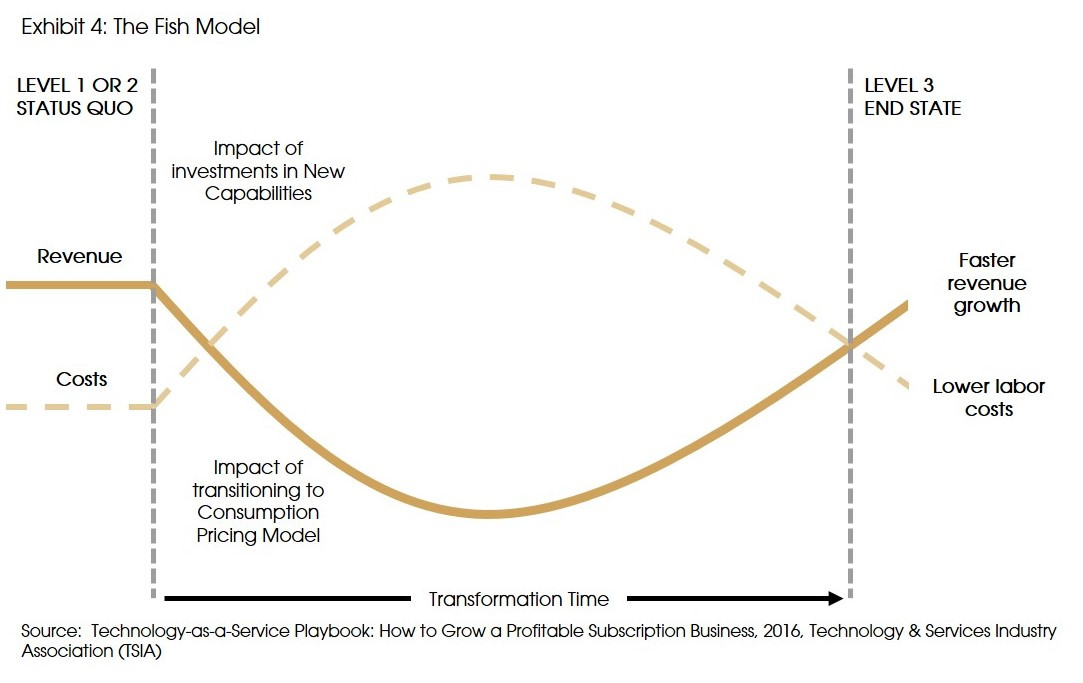
In 2011, Adobe faced the exact same dilemma when the company made the decision to transform their perpetual licensing business model to a subscription-based cloud service. At the time, Adobe was reeling from the impact of The Great Recession of 2008 on top of consecutive periods of flat revenue growth. Albeit an abundance of market opportunities, Adobe was unable to capitalize on market demands as their business model prevented them to do so. They were delivering software updates only every 18 or 24 months while their costumers creative requirements changed rapidly. The company was unable to get their existing customers to spend more on their products despite strong product reviews. The only alternative they had to accelerate revenue growth was through price increases. They quickly realized that it was not a sustainable strategy.
Adobe management took note that the underperformance versus their software counterparts in 2008 was attributed to the fact that they have little to no financial buffer from their cash inflows. Recurring revenues represented but a small portion of portfolio at just above (or under)5%. Consequently, Adobe revenue dropped by 20% and their valuation fell significantly.
Adobe felt a change was needed to revive growth and decided to fully transform their service offerings to a cloud-based subscription service. The company management went to great lengths in trying to convince stakeholders that it was a much-needed transformation for the firm. To its employees, the change meant new operating methods. They would have to alter revenue recordings and invoice billings. Products wise, it would translate into an increasing demand for more frequent updates to its software. To wall street analysts and investors, the change meant a complete reset of financial models and key metrics.
Many believe Adobe did an excellent job during the transitional period. In 2012, Adobe launched its key digital subscription product, Creative Suite, while keeping its traditional perpetual licensing model. They ran this parallel sales model for a year until 2013 when they fully switched to digital subscriptions. Even then, they did not pull the old product completely. Instead, they just stopped giving new updates on the product, which incentivized users to eventually change to the digital subscription model. Within 3 years, Adobe Creative Cloud went from no subscription revenue to 100% subscription model. Today, 90% of Adobe’s total revenue is subscription based.
In the end, Adobe managed to swallow the fish. When Adobe launched its key product line, Creative Suite, their net income fell by almost 35% in 2013. Prior to adopting a subscription model, Adobe’s revenue grew by 6.9% from 2007 to 2012. During the implementation phase in 2012-2014 it dropped to -2.96% only to grow at 21.9% CAGR from 2014 – 2019.
From this, we also learned that transparency is key. Adobe did an outstanding job in guiding its employees and investors throughout the transition period. Adobe went above and beyond in giving financial transparency with detailed new key metrics, ratios, and a comprehensive company guidance to help with the transition. A study by Harvard Business Review observed that investors increase their valuations of software vendor’s stock by an average of 2.2% if the vendor makes a clear announcement that a SaaS offering is provided in parallel to a perpetual licensing model. Today, the Adobe stock price has increased 10x in the span of 7 years.

From the Adobe success story, many followed suit (in particular technology companies). To name a few, Microsoft, Autodesk, Splunk, and Cisco. These companies have managed to successfully swallow their fish and accelerate revenue growth.
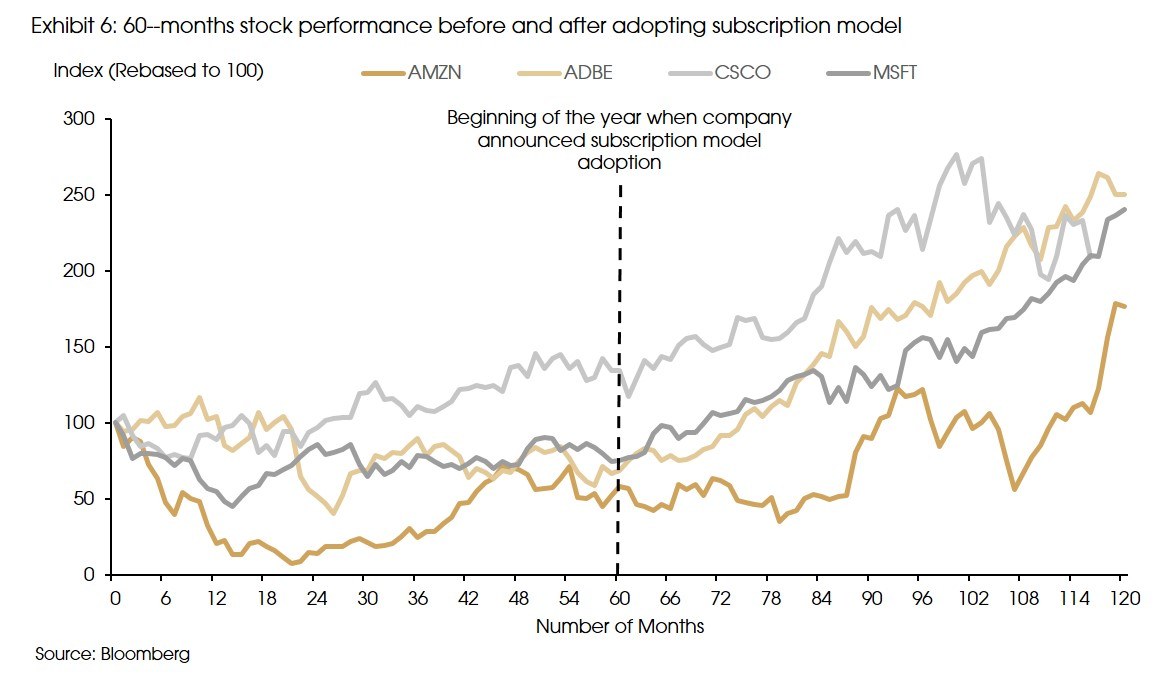
The Need for A New Financial Metrics
In his book “Subscribed”, Tien Tzuo argues that the traditional company income statement does not work for subscription-based businesses. Tzuo came to this realization after a presentation to his Zuora’s board which received quite a negative response.
Tzuo believes the traditional income statement does not work for three reasons: (1) A traditional income statement does not differentiate between recurring and non-recurring revenues, which essentially disregard the time value of money. (2) Sales and Marketing costs are matched with past good costs where it should be treated more strategically as an item driving future businesses. (3) Traditional income statements are backwards looking. However, subscription businesses are all about forward visibility. How much money can a business earn or count on over the next twelve months?
Following this, he offered a new concept, “The Subscription Economy Income Statement”. One that tries to fill a hole left by the old model. The basic idea is to derive a future annual recurring revenue while incorporating metrics that are essential to a subscription-based business such as Annual Recurring Revenue (ARR), Churn (dollar amount of lost subscribers), and Recurring Profit Margin. Since its conceptualization, this model has been shared and widely used by various companies and research analysts covering subscription businesses.
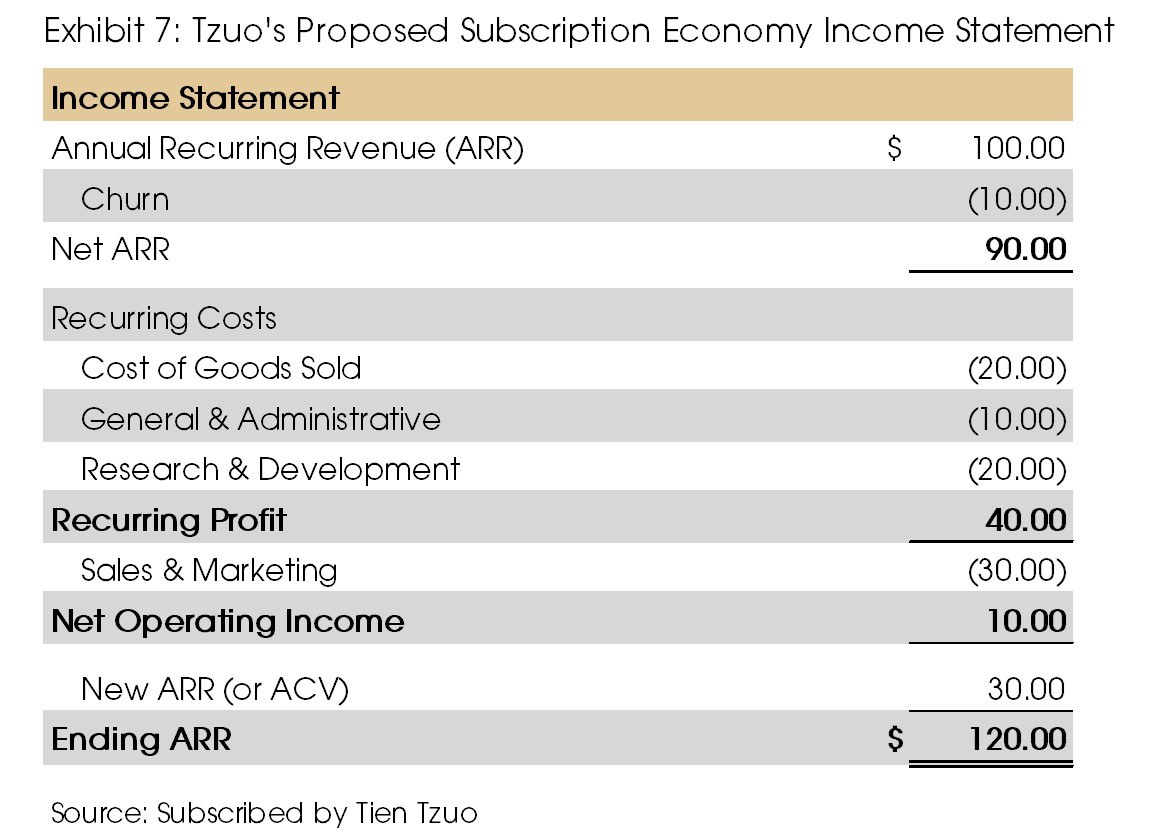
Subscription Businesses Performance and COVID-19
These days, it is almost impossible to talk about businesses and not talk about the impact of COVID-19. The notion of having recurring revenue in the middle of global uncertainties seems to be an attractive strategy to explore for investors yearning for a hint of resiliency. How has subscription-based businesses held during the COVID-19 pandemic?
The Economist reported that companies with subscription models have suffered less during the pandemic compared to other businesses. Subscription based firm’s revenue grew by 9.5% during the Q1 2020 while the S&P 500 contracted by 1.9% during the same period. What’s more is that the COVID-19 pandemic seems to have been a tipping point for some subscription-based business models. Zuora saw growth acceleration in services such as video streaming, news media, and e-learning services. Exhibit 8 highlights the growth observed from over 700 of Zuora customers’ worldwide.
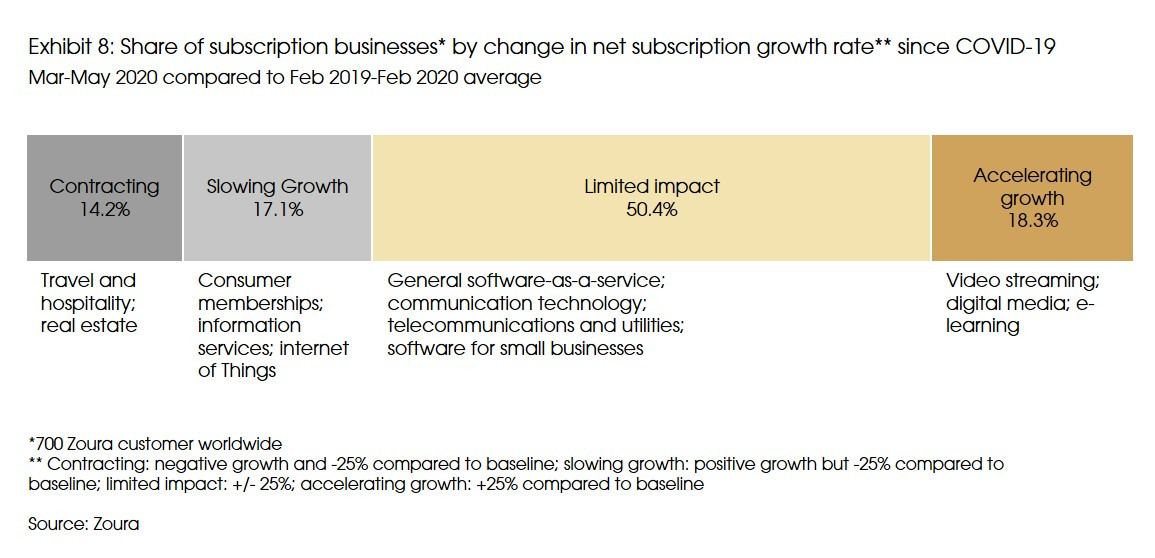
The Future of the Subscription Economy
One potential “drawback” from subscription economy is the possibility of “subscription fatigue” experienced by customers. Many argue that we might already be in that stage. However, according to a user survey by Zuora, only 7% of respondents stated they planned to subscribe to fewer services in the next two years. Exhibit 9 highlights the full survey result.
As noted by Natixis, in 2018 US consumers spent USD 237 a month in subscription services. Meanwhile in Europe, ING estimated that consumers spent an average of EUR 130 per month for subscriptions. Both numbers only represent ~5-6% of total consumer spending in each respective region which present more future opportunities to grow.

Conclusion
Without a doubt, the subscription-based business model provides a unique set of advantages both from a customer perspective as well as businesses and its’ stakeholders. The nature a subscription-based business model, which focuses on flexibility and experience, caters perfectly to the shift in consumer behavior that favors access over ownership. For businesses, better future revenue visibility will prove to be crucial as it helps management to better allocate resources to important areas such as research and development. In addition, subscription businesses will also benefit from a vast amount of customer purchasing data in order to provide more customization and personalization of its product/service offerings.
Overall, this leads us to believe there will continue to be attractive opportunities stemming from the rise of a subscription economy as businesses shift their operating model. By 2023, Gartner Research predicts that 75% of organizations selling direct to consumers will offer subscription services. However, we think that the subscription economy is only in its early stages. In time, we believe the Subscription Economy will attract more attention from investors as an appealing investment opportunity.
Source: Technology & Services Industry Association (TSIA), Zuora, Subscribed by Tien Tzuo, Harvard Business Review, Natixis Asset Management, Economist, McKinsey & Company


